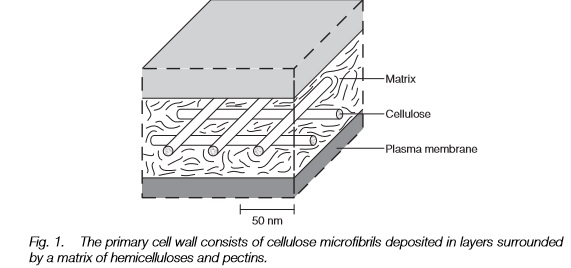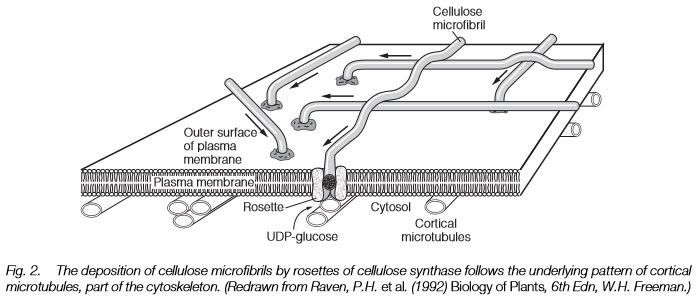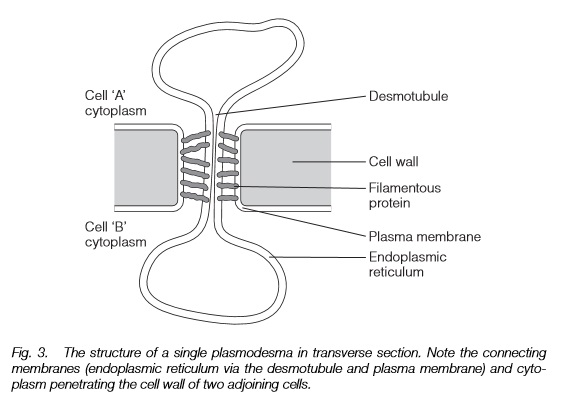Chapter: Plant Biology : Structure
Structure of Plant cell wall
THE CELL WALL
Cell wall structure
Primary cell walls are made up of cellulose microfibrils surrounded by a matrix of polysaccharides including hemicelluloses and pectins. Secondary cell walls contain cellulose microfibrils surrounded by polysaccharides and lignin.
Cell wall synthesis
Cellulose microfibrils are synthesized from uridine diphosphoglucose (UDP glucose) by cellulose synthase, an enzyme complex forming rosettes in the plasma membrane. Matrix materials are synthesized in the
Golgi apparatus and deposited into the wall by secretory vesicles that fuse with the plasma membrane.
Cell wall function
Cell walls are essential for adhesion and the growth and formation of the plant body. Primary cell walls have high tensile strength and oppose turgor. Lignified secondary walls give greater strength. Cell walls act as a barrier to pathogens and deter herbivory. Primary cell walls are generally permeable to water and small molecules. The dynamic nature of primary cell walls permits cell expansion and plant growth.
Plasmodesmata
Plasmodesmata are structures in which membranes from adjacent cells connect through a pore in the cell wall. They link adjacent plasma membranes and cytoplasm. The desmotubule is a tube of endoplasmic reticulum in the center of the pore surrounded by globular proteins. The structure permits regulated transport between the cells.
Cell wall structure
Almost all plant cells have a primary cell wall. It is made of a long-chain polysaccharide, cellulose, aggregated into bundles to form fibers,microfibrils 10–25 nm in diameter. The orientation of the microfibrils is governed by the cytoskeleton (see cell wall synthesis, below) and the fibers are laid down in a coordinated fashion so that the plasma membrane is covered in layers (Fig. 1). The orientation of the fibers changes as the cell develops. Microfibrils have a great tensile strength; their strength is further enhanced by interlinking between the fibrils by a matrix composed ofhemicelluloses and pectins. Between cells, there is a middle lamella, an adhesive region rich in pectic polysaccharides where adjacent cell walls adhere to one another.
Some cells of strengthening and vascular tissues develop a secondary cell wall, between the primary wall and the plasma membrane. Secondary cellwalls also contain cellulose microfibrils, infilled with polymerized phenolic compounds, lignins, that strengthen the wall. This is evident in wood(Topic C4). Lignin protects against digestion of the wall by fungal enzymes and against mechanical penetration by fungal hyphae and other pathogens (Topic M4).

Secondary walls are produced in layers, with the cellulose fibrils orientated in different directions; this ‘lamination’ gives considerable strength to the structure.
Cell wall synthesis
The primary cell wall is deposited while the cell is increasing in size. Cellulose is deposited by an enzyme complex, cellulose synthase that appears as a rosette in the membrane (Fig. 2). Cellulose is synthesized from uridine diphosphoglucose (UDP glucose) which is added simultaneously to the end of several strands, forming a cellulose fiber (or microfibril) at the cytoplasmic face of the membrane. As the strand elongates, the rosette moves in the membrane, extruding the strand to lie along the outer face of the membrane. The rosettes move parallel to fibers within the cell, the cortical microtubules. Matrixmaterials (hemicelluloses, lignin, pectic substances) are synthesized in the Golgi apparatus and transported to the plasma membrane in secretory vesicles that discharge their contents into the wall. New wall material is deposited at its inner face – that is the face adjacent to the plasma membrane.

Cell wall function
Primary cell walls have high tensile strength. They give strength to stems, leaves and roots, particularly by opposing turgor pressure from cell contents. They show plasticity and elasticity; as the cell grows, the dynamic structure of the wall means that it is able to adjust its structure to permit that growth. A new cell wall is rapidly formed after cell division. Cell walls prevent plasma membranes from contact except at pores, the plasmodesmata (see below).
Primary cell walls are permeable to water and low molecular weight molecules (ions, organic compounds and small proteins) which reach the plasma membrane. This movement is restricted if the wall is lignified or contains suberin as at the endodermis (Topic C2). Adjacent cell walls adhere at themiddle lamella, giving cell adhesion and allowing formation of tissues and organs. Lignification in secondary cell walls (Topic C4) greatly enhancescompressive strength, permitting woody structures more than 100 m tall. Cell walls also provide resistance to pathogens and herbivory.
Plasmodesmata
Plasmodesmata (singular plasmodesma) are structures in which membranes from adjacent cells connect through a pore in the cell wall (Fig. 3). The plasma membranes of the two adjacent cells join around the pore and a desmotubule, a tube of endoplasmic reticulum (ER), is present in the center of the pore, surrounded by globular proteins. This means that the plasma membrane, ER and cytoplasm of two adjacent cells adjoin. The structure permits regulated transport between the cells. Careful study of plant tissues reveal that many cells connect through plasmodesmata forming what could be considered to be colonies of cells all interconnected with their neighbors.
